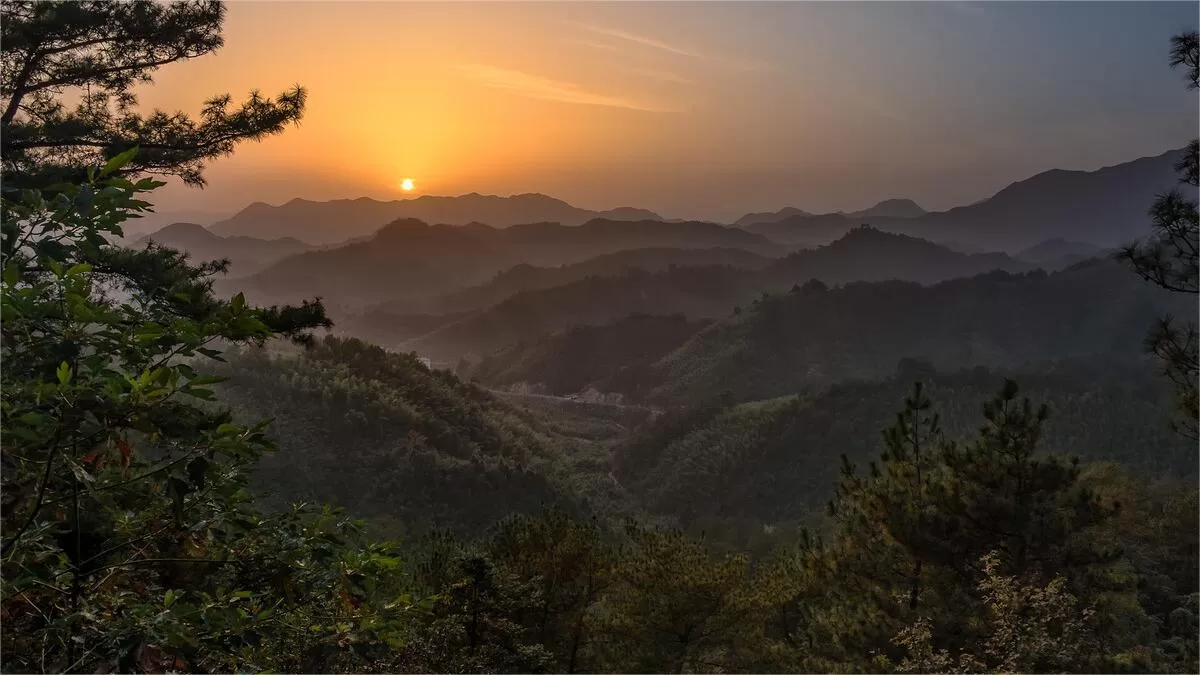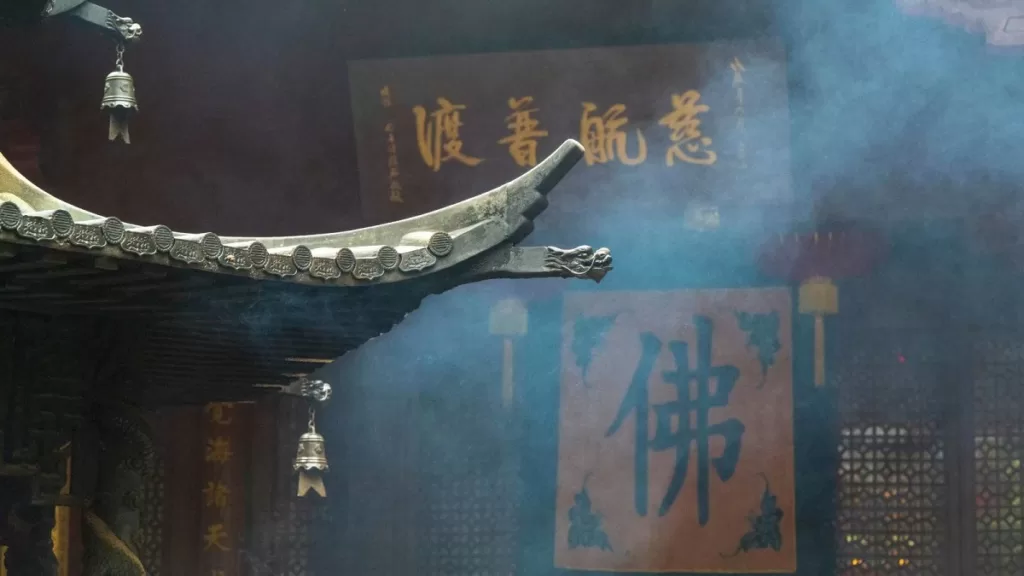Tianmu Mountain (天目山), renowned as the “broad tree canopy heard throughout China,” is situated in the northwest of Hangzhou, Zhejiang Province. Its main peak, Xianrending, stands at an elevation of 1506 meters. Formerly known as Fuyu Mountain, the name “Tianmu (sky eyes)” dates back to the Han Dynasty, deriving from its two peaks with perennial pools resembling gazing eyes towards the sky.
A sacred site associated with Weituo Bodhisattva, Tianmu Mountain has been revered as a religious destination since ancient times. The landscape is characterized by lush peaks, ancient trees, and a diverse array of flora and fauna, including rare species. The mountain boasts perilous cliffs with peculiar rocks, and its beauty is enhanced by cascading streams and waterfalls, earning it the reputation of the “Kingdom of Giant Trees” and the “Cool World.” Tianmu Mountain stands as a natural and spiritual gem, inviting visitors to explore its enchanting scenery and rich religious history.
Table of Contents
- Basic Information
- Location and Transportation
- Map of Tianmu Mountain
- Highlights of Tianmu Mountain
- Vlog about Tianmu Mountain
- Other Attractions in Lin’an District
- Other Iconic Attractions in Hangzhou
Basic Information
| Estimated Length of Tour | 1 day |
| Ticket Price | 136 RMB |
| Opening Hours | 8.00 – 16.00 |
| Telephone Number | 0086-0571-63857361 |
Location and Transportation
Tianmu Mountain is situated in the northwest part of Hangzhou City, within the territory of Lin’an District in Zhejiang Province, China. Positioned at the junction of Zhejiang and Anhui provinces, it is approximately 84 kilometers away from Hangzhou. To get there, you can choose one of the following ways:
Direct Bus from Hangzhou West Railway Station: Direct buses to West Tianmu Mountain are available at Hangzhou West Railway Station.
Public Bus Route 598C from Hangzhou West Bus Station: Take bus route 598C from Hangzhou West Bus Station, with buses departing approximately every 15 minutes. The bus will take you directly to Lin’an City. From Lin’an City, take a taxi or Bus Lin’an 2715 or 2819 to Tianmu Mountain.
Map of Tianmu Mountain

Highlights of Tianmu Mountain
Chanyuan Temple: A Sanctuary of Spiritual Legacy

Located at the southern foothills beneath the peaks of Zhaoming and Xuri, Chanyuan Temple, also known as Zen Source Monastery, is a sacred haven with roots dating back to the Yuan Dynasty. Originally established as the Lion’s Roar Zen Monastery, it holds the spiritual imprints associated with Weituo Bodhisattva. Surrounded by lush greenery and embraced by the tranquility of the mountains, Chanyuan Temple is renowned as one of the esteemed Buddhist temples in Zhejiang.
Throughout history, Chanyuan Temple has been a cradle of wisdom, with eminent monks propagating the teachings of the Linji school of Zen Buddhism. Its influence extends internationally, with frequent visits from Japanese Buddhist groups seeking ancestral connections and engaging in worship. During the tumultuous period of the Sino-Japanese War, Zen Source Temple served as the location for Zhejiang Provincial First High School and the temporary relocation of Zhejiang University.
On April 15, 1941, the temple endured the devastation of Japanese airstrikes, reducing the Mahavira Hall and eastern buildings to ashes. Despite this, recent reconstruction efforts have restored much of the temple’s grandeur. Today, visitors can witness the architectural revival of Chanyuan Temple, a testament to the enduring spirit of this historical site.
Kingdom of Giant Trees: Majestic Forest Legacy

Tianmu Mountain boasts the extraordinary title of the “Kingdom of Giant Trees,” and at its heart lies an unparalleled spectacle – the world-renowned Tianmu giant dawn redwood forest (Metasequoia glyptostroboides). These majestic trees create a stunning canopy that has captured the imagination of visitors for centuries.
The “Kingdom of Giant Trees” is home to a remarkable group of large dawn redwoods, with the largest boasting a trunk diameter of 2.75 meters. Nineteen trees exceed a diameter of 2 meters, and a staggering 664 trees surpass 1 meter in diameter. The youthful members, with diameters less than 1 meter, number in the tens of thousands.
Among the ancient giants, over 500 trees have surpassed the impressive age of 500 years, concentrated in the area between Wuliting and the Old Temple. One venerable tree, known as the “Millennium Tree,” earned its title during the Song Dynasty and had already reached a substantial size by the Ming Dynasty. Emperor Qianlong of the Qing Dynasty, during his southern tour, bestowed the title of “King of Giant Trees” upon this magnificent specimen. Since this legendary tree supposedly had healing properties attributed to its bark, the intense demand eventually led to its demise in the 1930s. Remarkably, even after more than 70 years of being lifeless, the “King of Giant Trees” still stands proudly, with a vibrant green shoot sprouting from its dry, majestic trunk.
Prince’s Hermitag: Echoes of Ancient Study

Legend has it that the Prince’s Hermitage was the place where Prince Xiao Tong of the Liang Dynasty engaged in scholarly pursuits. Located beneath the Zhaoming Peak to the northwest of Chanyuan Temple, the Prince’s Hermitage is enveloped in bamboo groves, with mountain springs splashing like jade, creating an ethereal setting. Covering an area of around 5 acres, the entrance gate is adorned with the inscription “Embracing Green Flowing Colors (抱翠流彩).” Within the hermitage lies the remnants of Zhaoming’s presence, including a study hall named 文选楼 (Wen Xuan Tower). The tower houses an ancient well named 太子井 (Prince’s Well), which miraculously never dries up. To the east of the study hall, there is a “Eye-Cleansing Pond (洗眼池),” where it is believed that Prince Zhaoming, suffering from eye ailments due to extensive reading, regained his sight by washing his eyes with the pond water.
Hanging Lotus Peak: Nature’s Artistry Unveiled

Also known as Lotus Flower Platform, Hanging Lotus Peak is a mesmerizing spectacle where verdant cliffs seem to part like a cleaved knife, revealing a square platform. Adjacent to the platform, towering stone stalagmites stand several meters high, arranged in a formation resembling a lotus flower. Legend has it that in the Yuan Dynasty, the venerable monk Gao Feng meditated atop the peak for three days and nights, fatigued and on the verge of falling, the mountain reversed itself, supporting the monk. The peak earned its name from this extraordinary event. At the square platform, there once stood the “Western Hermitage,” and later, the “Cloud-Piercing Pavilion” was erected, adding to the mystique of this natural masterpiece.
Five Generations Under One Roof: Ancient Ginkgo Legacy

Nestled in the grandeur of the Giant Tree King area, the Five Generations Under One Roof is a mesmerizing site located on a cliff below the Old Temple of Tianmu Mountain. Here stands the world’s oldest ginkgo tree, heralded as the “Ancestor of Ginkgos,” with a lineage that spans an incredible 12,000 years. This ancient ginkgo, a living testament to the passage of time, has given rise to 22 offshoots, symbolizing five generations thriving under its expansive canopy. Ginkgos are unique to China, surviving from the Mesozoic era as a relic plant. Beyond its aesthetic appeal, the ginkgo is a valuable medicinal plant, and every part of it holds economic significance. In close proximity, a rare and endangered plant, the Fragrant Fruit Tree, also thrives between the cracks of two large rocky outcrops, further enhancing the ecological richness of Tianmu Mountain.
Four-Faced Peak: Majestic Summit of Tranquility

Situated just a hundred meters east of the Hanging Lotus Peak, the Four-Faced Peak extends northward to the Jade Dragon Ridge, overlooking deep valleys on three sides. Adorned with pine and fir trees, their lush green leaves forming a majestic canopy, the summit is a spectacular sight. The peak, rising above surrounding valleys, offers a commanding view with steep cliffs that appear almost insurmountable. From its vantage point, the undulating mountain ranges, vast forests, and swirling clouds create a breathtaking panorama. Revered since the Ming Dynasty, Sheng Meng described the Four-Faced Peak in his “Travel Notes of Tianmu” as a place of profound depth, solitude, and scenic marvels, often referred to as the “Island of Penglai (the fairy island).” At the pinnacle, a Jade Pavilion stands, providing a perfect spot to take in the panoramic views. In 1934, renowned artist Xu Beihong, accompanied by students from the Central Academy of Fine Arts, visited West Tianmu for sketching and painting. Choosing the Old Temple as his residence, Xu Beihong created the oil painting “Autumn Scenery of Tianmu,” immortalizing the allure of the Four-Faced Peak.















Today, Tianmu Mountain is gorgeous!
The sky is crystal clear,
the greenery is vibrant and lush,
the breeze is refreshing.
It’s neither stuffy nor too sunny,
spacious and bright,
making me feel like I’ve traveled to a faraway place.